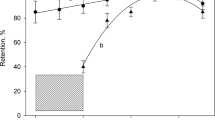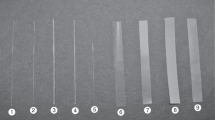Abstract
RELIABLE measurement of trace species in natural waters is essential for studies of pollution or trace-element cycling, but is difficult, partly because the distribution of chemical species often changes during sampling and storage1. In situ measurements can overcome these problems, but the few measurements made previously have involved complicated systems that cannot be used routinely1,2. Here we describe a simple technique for measuring trace-metal concentrations in situ in water. The technique incorporates an ion-exchange resin separated from the solution by an ion-permeable gel membrane. Mass transport through the gel is diffusion-controlled and thus well defined, making it possible to obtain quantitative data on concentration and speciation over relatively short time periods (from one hour to several weeks). We present measurements of zinc concentrations in sea water using this technique which agree well with electrochemical measurements. In principle, our technique should be applicable to any inorganic or organic diffusing species.
This is a preview of subscription content, access via your institution
Access options
Subscribe to this journal
Receive 51 print issues and online access
$199.00 per year
only $3.90 per issue
Buy this article
- Purchase on Springer Link
- Instant access to full article PDF
Prices may be subject to local taxes which are calculated during checkout
Similar content being viewed by others
Change history
12 June 2018
In the version of this Letter originally published, the title was missing a space between situ and speciation and the author name was incorrectly stated as W. Davlson rather than W. Davison. Both have been corrected.
References
Tercier, M. L., Buffle, J., Zirino, A. & De Vitre, R. R. Analytica chim. Acta 237, 429–437 (1990).
Davey, E. W. & Soper, A. E. Limnol. Oceanogr. 20, 1019–1023 (1975).
Buffle, J. Complexation Reactions in Aquatic Systems (Ellis-Horwood, Chichester, 1988).
Morrison, G. M. P. Envir. Technol. Lett. 8, 393–402 (1987).
Davison, W., Grime, G. W., Morgan, J. A. W. & Clarke, K. Nature 352, 323–325 (1991).
W. E. Reinlove, J. phys. Chem. 96, 10–19 (1993).
Santschi, P., Hohener, P., Benoit, G. & Buchholtz-ten Brink, M. Mar. Chem. 30, 269–315 (1990).
Chrambach, A. The Practice of Quantitative Gel Electrophoresis (VCH, Weinheim, 1985).
Li, Y. & Gregory, S. Geochim. cosmochim. Acta 38, 703–714 (1974).
Snodgrass, W. J. in Sediments and Water Interactions (ed. Sly, P.G.) (Springer, New York, 1986).
Davison, W. J. Electroanal. Chem. 87, 395–404 (1978).
Lopez, P. B., Bajdik, C. D., Belkhode, S. P., Jackson, S. E. & Longerich, H. P. Arch. Envir. Contam. Tox. 21, 409–420 (1991).
Author information
Authors and Affiliations
Rights and permissions
About this article
Cite this article
Davison, W., Zhang, H. In situ speciation measurements of trace components in natural waters using thin-film gels. Nature 367, 546–548 (1994). https://doi.org/10.1038/367546a0
Received:
Accepted:
Issue Date:
DOI: https://doi.org/10.1038/367546a0
This article is cited by
-
In Situ Understanding of the Effect of Manure on the Availability of Sulfonamide Antibiotics in Soils Using DGT
Bulletin of Environmental Contamination and Toxicology (2024)
-
Adaptation of the o-DGT for the sampling of 12 hormones: calibration, performance evaluation, and recommendation
Environmental Science and Pollution Research (2023)
-
A novel method for in situ imaging of root exudates and labile elements reveals phosphorus deficiency-induced mobilization of rare earth elements in the rhizosphere of Phytolacca americana
Plant and Soil (2023)
-
Passive Sampling: A Greener Technique for the ‘Dual Carbon’ Goal While Implementing the Action Plan for Controlling Emerging Pollutants
Bulletin of Environmental Contamination and Toxicology (2023)
-
Characterization of iron, sulfur, and phosphorus diagenesis in muddy sediments of the South Yellow Sea using the diffusive gradients in thin films (DGT) technique
Aquatic Sciences (2023)
Comments
By submitting a comment you agree to abide by our Terms and Community Guidelines. If you find something abusive or that does not comply with our terms or guidelines please flag it as inappropriate.



